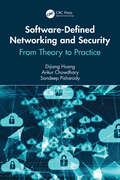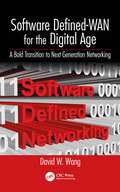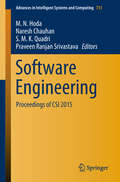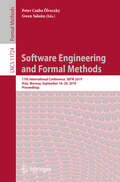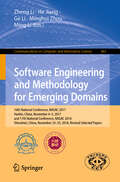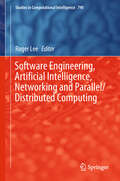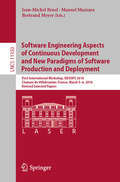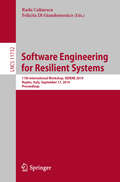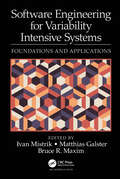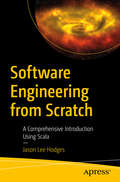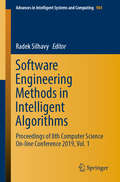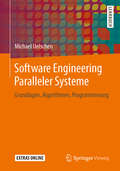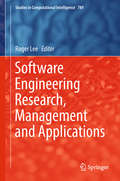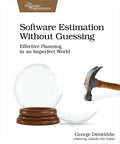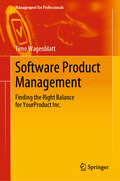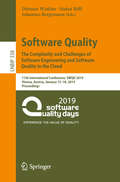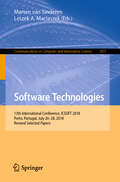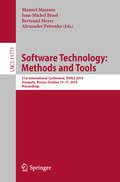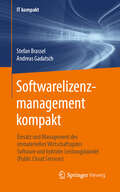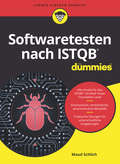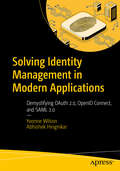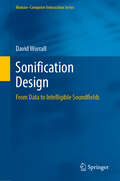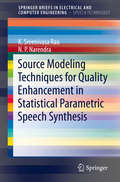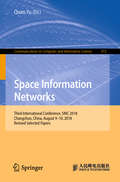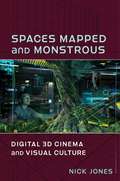- Table View
- List View
Software-Defined Networking and Security: From Theory to Practice (Data-Enabled Engineering)
by Dijiang Huang Ankur Chowdhary Sandeep PisharodyThis book provides readers insights into cyber maneuvering or adaptive and intelligent cyber defense. It describes the required models and security supporting functions that enable the analysis of potential threats, detection of attacks, and implementation of countermeasures while expending attacker resources and preserving user experience. This book not only presents significant education-oriented content, but uses advanced content to reveal a blueprint for helping network security professionals design and implement a secure Software-Defined Infrastructure (SDI) for cloud networking environments. These solutions are a less intrusive alternative to security countermeasures taken at the host level and offer centralized control of the distributed network. The concepts, techniques, and strategies discussed in this book are ideal for students, educators, and security practitioners looking for a clear and concise text to avant-garde cyber security installations or simply to use as a reference. Hand-on labs and lecture slides are located at http://virtualnetworksecurity.thothlab.com/. Features Discusses virtual network security concepts Considers proactive security using moving target defense Reviews attack representation models based on attack graphs and attack trees Examines service function chaining in virtual networks with security considerations Recognizes machine learning and AI in network security
Software Defined-WAN for the Digital Age: A Bold Transition to Next Generation Networking
by David W. WangSD-WAN is an advanced networking approach that creates hybrid networks to integrate broadband or other network services into the corporate WAN, not only just handling general business workloads and traffic, but also being capable of maintaining the performance and security of real-time and sensitive applications. This book posits that Software Defined (SD) WAN is the answer to questions such as what changes can be made to the networking sector? What innovations can make WAN, which plays a vital integrated part of the cloud ecosystem, more cost effective, performance robust, provisioning efficient, and operation intelligent?
Software Engineering: Proceedings of CSI 2015 (Advances in Intelligent Systems and Computing #731)
by M. N. Hoda Naresh Chauhan S. M. Quadri Praveen Ranjan SrivastavaThis book presents selected proceedings of the annual convention of the Computer Society of India. Divided into 10 topical volumes, the proceedings present papers on state-of-the-art research, surveys, and succinct reviews. They cover diverse topics ranging from communications networks to big data analytics, and from system architecture to cyber security. This book focuses on Software Engineering, and informs readers about the state of the art in software engineering by gathering high-quality papers that represent the outcomes of consolidated research and innovations in Software Engineering and related areas. In addition to helping practitioners and researchers understand the chief issues involved in designing, developing, evolving and validating complex software systems, it provides comprehensive information on developing professional careers in Software Engineering. It also provides insights into various research issues such as software reliability, verification and validation, security and extensibility, as well as the latest concepts like component-based development, software process models, process-driven systems and human-computer collaborative systems.
Software Engineering and Formal Methods: 17th International Conference, SEFM 2019, Oslo, Norway, September 18–20, 2019, Proceedings (Lecture Notes in Computer Science #11724)
by Peter Csaba Ölveczky Gwen SalaünThis book constitutes the refereed proceedings of the 17th International Conference on Software Engineering and Formal Methods, SEFM 2019, held in Oslo, Norway, in September 2019.The 27 full papers presented were carefully reviewed and selected from 89 submissions. The papers cover a large variety of topics, including testing, formal verification, program analysis, runtime verification, malware and attack detection,and software development and evolution and address a wide range of systems, such as cyber-physical systems, UAVs, autonomous robots, and feature-oriented and operating systems. They are organized in the following topical sections: cooperative asynchronous systems; cyber-physical systems; feature-oriented and versioned systems; model-based testing; model inference; ontologies and machine learning; operating systems; program analysis; relating models and implementations; runtime verification; security; and verification.
Software Engineering and Methodology for Emerging Domains: 16th National Conference, NASAC 2017, Harbin, China, November 4–5, 2017, and 17th National Conference, NASAC 2018, Shenzhen, China, November 23–25, 2018, Revised Selected Papers (Communications in Computer and Information Science #861)
by Zheng Li He Jiang Ge Li Minghui Zhou Ming LiThis book constitutes the thoroughly refereed proceedings of the 16th National Conference, NASAC 2017, held in Harbin, China, in November 2017, and the 17th National Conference, NASAC 2018, held in Shenzhen, China, in November 2018. The 6 revised selected papers were selected from 17 submissions for NASAC 2017, and 5 revised selected papers were selected from 20 submissions for NASAC 2018. The papers focus on all aspects of software engineering, e.g. requirements engineering, software methodologies, software analytics, software testing and evolution, and empirical studies.
Software Engineering, Artificial Intelligence, Networking and Parallel/Distributed Computing (Studies in Computational Intelligence #149)
by Roger LeeThis edited book presents the scientific outcomes of the 19th IEEE/ACIS International Conference on Software Engineering, Artificial Intelligence, Networking and Parallel/Distributed Computing (SNPD 2018), which was held in Busan, Korea on June 27–29, 2018. The aim of this conference was to bring together researchers and scientists, businessmen and entrepreneurs, teachers, engineers, computer users and students to discuss the numerous fields of computer science and to share their experiences and exchange new ideas and information in a meaningful way. The book includes research findings on all aspects (theory, applications and tools) of computer and information science and discusses the practical challenges encountered along the way and the solutions adopted to respond to them. The book includes 13 of the conference’s most promising papers.
Software Engineering Aspects of Continuous Development and New Paradigms of Software Production and Deployment: First International Workshop, DEVOPS 2018, Chateau de Villebrumier, France, March 5-6, 2018, Revised Selected Papers (Lecture Notes in Computer Science #11350)
by Jean-Michel Bruel Manuel Mazzara Bertrand MeyerThis book constitutes revised selected papers from the First International Workshop on Software Engineering Aspects of Continuous Development and New Paradigms of Software Production and Deployment, DEVOPS 2018, hled at the hateau de Villebrumier, France, in March 2018. The 17 papers presented in this volume were carefully reviewed and selected from 23 submissions. They cover a wide range of problems arising from Devops and related approaches, current tools, rapid development-deployment processes, effects on team performance, analytics, trustworthiness, microservices and related topics.
Software Engineering for Resilient Systems: 11th International Workshop, SERENE 2019, Naples, Italy, September 17, 2019, Proceedings (Lecture Notes in Computer Science #11732)
by Radu Calinescu Felicita Di GiandomenicoThis book constitutes the refereed proceedings of the 11th International Workshop on Software Engineering for Resilient Systems, SERENE 2019, held in Naples, Italy, in September 2019. The 5 full papers and 4 short papers presented together with 1 keynote and 1 invited paper were carefully reviewed and selected from 12 submissions. They cover the following areas: resilience engineering in complex and critical applications; testing and validation methods; security, trust and privacy management.
Software Engineering for Variability Intensive Systems: Foundations and Applications
by Ivan Mistrik Matthias Galster Bruce R. MaximThis book addresses the challenges in the software engineering of variability-intensive systems. Variability-intensive systems can support different usage scenarios by accommodating different and unforeseen features and qualities. The book features academic and industrial contributions that discuss the challenges in developing, maintaining and evolving systems, cloud and mobile services for variability-intensive software systems and the scalability requirements they imply. The book explores software engineering approaches that can efficiently deal with variability-intensive systems as well as applications and use cases benefiting from variability-intensive systems.
Software Engineering from Scratch: A Comprehensive Introduction Using Scala
by Jason Lee HodgesLearn software engineering from scratch, from installing and setting up your development environment, to navigating a terminal and building a model command line operating system, all using the Scala programming language as a medium. The demand for software engineers is growing exponentially, and with this book you can start your journey into this rewarding industry, even with no prior programming experience.Using Scala, a language known to contain “everything and the kitchen sink,” you’ll begin coding on a gentle learning curve by applying the basics of programming such as expressions, control flow, functions, and classes. You’ll then move on to an overview of all the major programming paradigms. You’ll finish by studying software engineering concepts such as testing and scalability, data structures, algorithm design and analysis, and basic design patterns. With Software Engineering from Scratch as your navigator, you can get up to speed on the software engineering industry, develop a solid foundation of many of its core concepts, and develop an understanding of where to invest your time next. What You Will LearnUse Scala, even with no prior knowledgeDemonstrate general Scala programming concepts and patternsBegin thinking like a software engineerWork on every level of the software development cycleWho This Book Is ForAnyone who wants to learn about software engineering; no prior programming experience required.
Software Engineering Methods in Intelligent Algorithms: Proceedings of 8th Computer Science On-line Conference 2019, Vol. 1 (Advances in Intelligent Systems and Computing #984)
by Radek SilhavyThis book presents software engineering methods in the context of the intelligent systems. It discusses real-world problems and exploratory research describing novel approaches and applications of software engineering, software design and algorithms. The book constitutes the refereed proceedings of the Software Engineering Methods in Intelligent Algorithms Section of the 8th Computer Science On-line Conference 2019 (CSOC 2019), held on-line in April 2019.
Software Engineering Paralleler Systeme: Grundlagen, Algorithmen, Programmierung
by Michael UelschenMichael Uelsen beleuchtet die Softwareentwicklung aus verschiedenen Sichtweisen. In der Einführung seines Buches über das Software Engineering stellt er Anwendungsfälle dar und erläutert die Herausforderungen bei der Arbeit mit parallelen Systemen. Anschließend bringt er die Eigenschaften und Besonderheiten paralleler Systeme und Algorithmen zur Sprache. Es geht dabei vor allem um Präfixsummen, Sortier- und rekursive Suchverfahren. Daneben spielen aber auch CPU-Programmierung, GPU-Programmierung und moderne Programmiersprachen eine tragende Rolle in diesem Werk.
Software Engineering Research, Management and Applications (Studies in Computational Intelligence #789)
by Roger LeeThis book presents the outcomes of the 16th International Conference on Software Engineering, Artificial Intelligence Research, Management and Applications (SERA 2018), which was held in Kunming, China on June 13–15, 2018. The aim of the conference was to bring together researchers and scientists, businessmen and entrepreneurs, teachers, engineers, computer users, and students to discuss the various fields of computer science, to share their experiences, and to exchange new ideas and information in a meaningful way. The book includes findings on all aspects (theory, applications and tools) of computer and information science, and discusses related practical challenges and the solutions adopted to solve them.The conference organizers selected the best papers from those accepted for presentation. The papers were chosen based on review scores submitted by members of the program committee and underwent a further rigorous round of review. From this second round, 13 of the conference’s most promising papers were then published in this Springer (SCI) book and not the conference proceedings. We eagerly await the important contributions that we know these authors will make to the field of computer and information science.
Software Estimation Without Guessing: Effective Planning in an Imperfect World
by George DinwiddieEstimating software development often produces more angst than value, but it doesn't have to. Identify the needs behind estimate requests and determine how to meet those needs simply and easily. Choose estimation techniques based on current needs and available information, gaining benefit while reducing cost and effort. Detect bad assumptions that might sink your project if you don't adjust your plans. Discover what to do when an estimate is wrong, how to recover, and how to use that knowledge for future planning. Learn to communicate about estimates in a healthy and productive way, maximizing advantage to the organization and minimizing damage to the people. In a world where most developers hate estimation and most managers fear disappointment with the results, there is hope for both. It requires giving up some widely held misconceptions. Let go of the notion that "an estimate is an estimate" and estimate for the particular need you, and your organization, have. Realize that estimates have a limited shelf-life, and reestimate frequently if it's important. When reality differs from your estimate, don't lament; mine that disappointment for the gold that can be the longer-term jackpot. Estimate in comparison to past experience, by modeling the work mathematically, or a hybrid of both. Learn strategies for effective decomposition of work and aspects of the work that likely affect your estimates. Hedge your bets by comparing the results of different approaches. Find out what to do when an estimate proves wrong. And they will. They're estimates, after all. You'll discover that you can use estimates to warn you of danger so you can take appropriate action in time. Learn some crucial techniques to understand and communicate with those who need to understand. Address both the technical and sociological aspects of estimation, and you'll help your organization achieve its desired goals with less drama and more benefit. What You Need: No software needed, just your past experience and concern for the outcomes.
Software Product Management: Finding the Right Balance for YourProduct Inc. (Management for Professionals)
by Timo WagenblattThis book is for product managers, product owners, product marketing managers, VPs and Heads of Product, CEOs, and start-up founders. In short, it serves anyone interested personally or professionally in software product management. You’ll learn how to plan, coordinate and execute all activities required for software product success. It enables you to find the right balance for delivering customer value and long-term product success.The book offers a comprehensive introduction for beginners as well as proven practices and a novel, holistic approach for experienced product managers. It provides much-needed clarity regarding the numerous tasks and responsibilities involved in the professional and successful management of software products. Readers can use this book as a reference book if they are interested in or have the urgent need to improve one of the following software product management dimensions: Product Viability, Product Development, Go-to-Market / Product Marketing, Software Demonstrations and Training, The Market / Your Customers, or Organizational Maturity.The book helps product people to maximize their impact and effectiveness. Whether you’re a seasoned practitioner, new to software product management, or just want to learn more about the best-of-all disciplines and advance your skills, this book introduces a novel and “business” tested approach to structure and orchestrate the vital dimensions of software product management. You will learn how to create focus and alignment on the things that matter for product success.The book describes a holistic framework to keep the details that matter for product success in balance, taking into consideration the limiting factors, strategies and responsibilities that determine the overall product yield potential. It explains how to leverage and adapt the framework with regard to aspects like product viability, product development, product marketing and software demonstrations and training, as well as more general aspects like markets, customers and organizational maturity.The book focuses on the unique challenges of software product managers or any related roles, whether you are a founder of a small to mid-sized software company or working in the complex ecosystems of large software enterprises or corporate IT departments.
Software Quality: 11th International Conference, SWQD 2019, Vienna, Austria, January 15–18, 2019, Proceedings (Lecture Notes in Business Information Processing #338)
by Dietmar Winkler Stefan Biffl Johannes BergsmannThis book constitutes the refereed proceedings of the 11th Software Quality Days Conference, SWQD 2019, held in Vienna, Austria, in January 2019. The Software Quality Days (SWQD) conference started in 2009 and has grown to the biggest conference on software quality in Europe with a strong community. The program of the SWQD conference is designed to encompass a stimulating mixture of practical presentations and new research topics in scientific presentations. The guiding conference topic of the SWQD 2019 is “The Complexity and Challenges of Software Engineering and Software Quality in the Cloud”. The 5 full papers and 3 short papers presented in this volume were carefully reviewed and selected from 17 submissions. The volume also contains 2 invited talks. The contributions were organized in topical sections named: multi-disciplinary systems and software engineering; software quality and process improvement; software testing; knowledge engineering and machine learning; source code analysis; and software maintenance.
Software Technologies: 13th International Conference, ICSOFT 2018, Porto, Portugal, July 26-28, 2018, Revised Selected Papers (Communications in Computer and Information Science #1077)
by Marten Van Sinderen Leszek A. MaciaszekThis book constitutes the thoroughly refereed post-conference proceedings of the 13th International Joint Conference on Software Technologies, ICSOFT 2018, held in Porto, Portugal, in July 2018.The 18 revised full papers were carefully reviewed and selected from 117 submissions. The topics covered in the papers include: business process modelling, IT service management, interoperability and service-oriented architecture, project management software, scheduling and estimating, software metrics, requirements elicitation and specification, software and systems integration, etc.
Software Technology: 51st International Conference, TOOLS 2019, Innopolis, Russia, October 15–17, 2019, Proceedings (Lecture Notes in Computer Science #11771)
by Manuel Mazzara Jean-Michel Bruel Bertrand Meyer Alexander PetrenkoThis book constitutes the refereed proceedings of the 51st International Conference on Software Technology: Methods and Tools, TOOLS 2019, held in Innopolis, Russia, in October 2019.The 19 revised full papers and 13 short papers presented in this book were carefully reviewed and selected from 62 submissions. The papers discuss all aspects of software engineering and programming languages; machine learning; internet of things; security computer architectures and robotics; and projects.
Softwarelizenzmanagement kompakt: Einsatz und Management des immateriellen Wirtschaftsgutes Software und hybrider Leistungsbündel (Public Cloud Services) (IT kompakt)
by Stefan Brassel Andreas GadatschDieses Buch setzt sich mit den Veränderungen im Softwarelizenzmanagement auseinanderDie Autoren geben einen Überblick über Neuerungen und Veränderungen im Softwarelizenzmanagement und zeigen, wie sie sich auf das Management von Unternehmen auswirken. Dazu präsentieren sie praxisnahe Ansätze und Handlungsempfehlungen, die auf theoretischen Erkenntnissen basieren. Bisher hat sich die Fachliteratur diesem Thema, wenn überhaupt, nur aus operativer Sicht genähert. Das möchte dieses Werk ändern. Deshalb zielt dieses Buch darauf ab, fachliche Zusammenhänge im Bereich des Softwarelizenzmanagements für Sie nachvollziehbar darzustellen. Daneben gehen Stefan Brassel und Andreas Gadatsch auf aktuelle Marktveränderungen ein und geben konkrete Impulse für das (IT-)Management. Durch diese Herangehensweise gelingt den Autoren ein Brückenschlag zwischen der Theorie und Anwendbarkeit ihrer Feststellungen. Neben zentralen Grundlagen enthält das Buch viele Praxisbeispiele aus dem Softwarelizenzmanagement. Ein wichtiger Schwerpunkt dieses Werks ist außerdem die Transformation von Softwarelizenzen hin zu Public Cloud Services. Von der Theorie zum Fokus auf die Praxis Zunächst liegt der Fokus dieses Werks auf der Theorie, doch hier halten sich die Autoren nur kurz auf. Sie erfahren z. B. mehr über die klare Abgrenzung zentraler Begriffe wie „Softwarelizenz“ und „Softwarelizenzmanagement“. Auch die Problematik immaterieller Wirtschaftsgüter sowie deren Nutzungsrechte werden behandelt. Anschließend geht das Buch „Softwarelizenzmanagement kompakt” stärker in die Tiefe und erläutert Themen wie:· Praxis der Softwarelizenzierung am Beispiel Microsoft· Transformation: Von der Software Lizenz zu Public Cloud Services· IT-Assetmanagement von Software und Public Cloud-Diensten Abschließend erhalten Sie Handlungsempfehlungen für das Management sowie für eine evtl. notwendige strategische Neuausrichtung von Unternehmen. Erschienen in der Reihe „IT kompakt“, ermöglicht Ihnen dieses Buch über Softwarelizenzmanagement einen schnellen und vor allen Dingen praxisorientierten Einstieg in die Thematik. Daher eignet es sich optimal für Selbststudium und Lehre. Durch den grundlegenden Fokus auf Veränderungen im Softwaremarkt wurde dieses Werk speziell für diese Zielgruppen verfasst:a) Fachverantwortliche des IT-Lizenzmanagementsb) Führungskräfte in der Unternehmensleitung oder in IT-Abteilungenc) Verantwortliche des Geschäftsprozessmanagementsd) Masterstudierende der BWL, Informatik oder Wirtschaftsinformatik
Softwaretesten nach ISTQB für Dummies (Für Dummies)
by Maud SchlichSoll in Ihrem Unternehmen neue Software eingeführt werden und Sie sollen sie testen? Und Sie wissen nicht, wie Sie das angehen sollen? Oder wollen Sie als Entwickler über den Tellerrand schauen und sich auch mit dem Softwaretesten beschäftigen? Dieses Buch erläutert alle vom ISTQB® Certified Tester Foundation Level geforderten Lerninhalte sowohl für den Anwender mit Fachkenntnissen, der Software später einsetzen wird, als auch für den Programmierer. Die Übungen sind leicht in die eigene Praxis übertragbar und sorgen für eine optimale Prüfungsvorbereitung. Darüber hinaus wird für alle Testaktivitäten gezeigt, wie diese jeweils im klassischen oder im agilen Kontext aussehen.
Solving Identity Management in Modern Applications: Demystifying OAuth 2.0, OpenID Connect, and SAML 2.0
by Yvonne Wilson Abhishek HingnikarKnow how to design and use identity management to protect your application and the data it manages.At a time when security breaches result in increasingly onerous penalties, it is paramount that application developers and owners understand identity management and the value it provides when building applications. This book takes you from account provisioning to authentication to authorization, and covers troubleshooting and common problems to avoid. The authors include predictions about why this will be even more important in the future. Application best practices with coding samples are provided.Solving Identity and Access Management in Modern Applications gives you what you need to design identity and access management for your applications and to describe it to stakeholders with confidence. You will be able to explain account creation, session and access management, account termination, and more. What You’ll Learn Understand key identity management conceptsIncorporate essential design principlesDesign authentication and access control for a modern applicationKnow the identity management frameworks and protocols used today (OIDC/ OAuth 2.0, SAML 2.0)Review historical failures and know how to avoid them Who This Book Is For Developers, enterprise or application architects, business application or product owners, and anyone involved in an application's identity management solution
Sonification Design: From Data to Intelligible Soundfields (Human–Computer Interaction Series)
by David WorrallThe contemporary design practice known as data sonification allows us to experience information in data by listening. In doing so, we understand the source of the data in ways that support, and in some cases surpass, our ability to do so visually. In order to assist us in negotiating our environments, our senses have evolved differently. Our hearing affords us unparalleled temporal and locational precision. Biological survival has determined that the ears lead the eyes. For all moving creatures, in situations where sight is obscured, spatial auditory clarity plays a vital survival role in determining both from where the predator is approaching or to where the prey has escaped. So, when designing methods that enable listeners to extract information from data, both with and without visual support, different approaches are necessary. A scholarly yet approachable work by one of the recognized leaders in the field of auditory design, this book will - Lead you through some salient historical examples of how non-speech sounds have been used to inform and control people since ancient times. - Comprehensively summarize the contemporary practice of Data Sonification. - Provide a detailed overview of what information is and how our auditory perceptions can be used to enhance our knowledge of the source of data. - Show the importance of the dynamic relationships between hearing, cognitive load, comprehension, embodied knowledge and perceptual truth. - Discuss the role of aesthetics in the dynamic interplay between listenability and clarity. - Provide a mature software framework that supports the practice of data sonification design, together with a detailed discussion of some of the design principles used in various examples. David Worrall is an internationally recognized composer, sound artist and interdisciplinary researcher in the field of auditory design. He is Professor of Audio Arts and Acoustics at Columbia College Chicago and a former elected president of the International Community for Auditory Display (ICAD), the leading organization in the field since its inception over 25 years ago.Code and audio examples for this book are available athttps://github.com/david-worrall/springer/ Here is an excellent review of the book by Dr Gregory Kramer: “Worrall proceeds bravely through the trees and vines of philosophy, information theory, aesthetics, and other contributors to sonification design theory. It’s a feat. He nails all of this down with the specific implementation system he’s designed over many years, and applies his theories to specific problems. In a field of research still in its first half century and setting its bearings in a world where human perception has become a sideshow to machine learning, deep learning, and artificial intelligence, the roots David provides will serve well.” Dr Gregory Kramer is the founding figure in the emerging field of sonification, founded the International Conference on Auditory Display (ICAD) and editor of the first book in the field, "Auditory Display: Sonification, Audification and Auditory Interfaces" (Addison Wesley, 1994).
Source Modeling Techniques for Quality Enhancement in Statistical Parametric Speech Synthesis (SpringerBriefs in Speech Technology)
by K. Sreenivasa Rao N. P. NarendraThis book presents a statistical parametric speech synthesis (SPSS) framework for developing a speech synthesis system where the desired speech is generated from the parameters of vocal tract and excitation source. Throughout the book, the authors discuss novel source modeling techniques to enhance the naturalness and overall intelligibility of the SPSS system. This book provides several important methods and models for generating the excitation source parameters for enhancing the overall quality of synthesized speech. The contents of the book are useful for both researchers and system developers. For researchers, the book is useful for knowing the current state-of-the-art excitation source models for SPSS and further refining the source models to incorporate the realistic semantics present in the text. For system developers, the book is useful to integrate the sophisticated excitation source models mentioned to the latest models of mobile/smart phones.
Space Information Networks: Third International Conference, SINC 2018, Changchun, China, August 9–10, 2018, Revised Selected Papers (Communications in Computer and Information Science #972)
by Quan YuThis book constitutes the proceedings of the Third International Conference on Space Information Networks, SINC 2018, held in Changchun, China, in August 2018. The 17 full and 7 short papers presented in this volume were carefully reviewed and selected from 140 submissions. The papers are organized in topical sections on architecture and efficient networking mechanism; theories and methods of high speed transmission; and sparse characterization and fusion processing.
Spaces Mapped and Monstrous: Digital 3D Cinema and Visual Culture (Film and Culture Series)
by Nick JonesDigital 3D has become a core feature of the twenty-first-century visual landscape. Yet 3D cinema is a contradictory media form: producing spaces that are highly regimented and exhaustively detailed, it simultaneously relies upon distortions of vision and space that are inherently strange.Spaces Mapped and Monstrous explores the paradoxical nature of 3D cinema to offer a critical analysis of an inescapable part of contemporary culture. Considering 3D’s distinctive visual qualities and its connections to wider digital systems, Nick Jones situates the production and exhibition of 3D cinema within a web of aesthetic, technological, and historical contexts. He examines 3D’s relationship with computer interfaces, virtual reality, and digital networks as well as tracing its lineage to predigital models of visual organization. Jones emphasizes that 3D is not only a technology used in films but also a tool for producing, controlling, and distorting space within systems of surveillance, corporatization, and militarization. The book features detailed analysis of a wide range of films—including Avatar (2009), Goodbye to Language (2014), Love (2015), and Clash of the Titans (2010)—demonstrating that 3D is not merely an augmentation of 2D cinema but that it has its own unique properties. Spaces Mapped and Monstrous brings together media archaeology, digital theory, and textual analysis to provide a new account of the importance of 3D to visual culture today.
